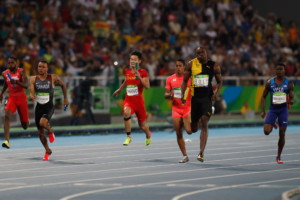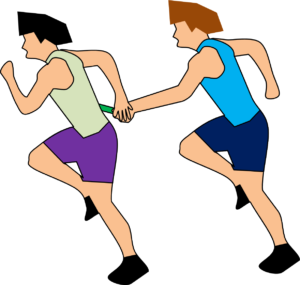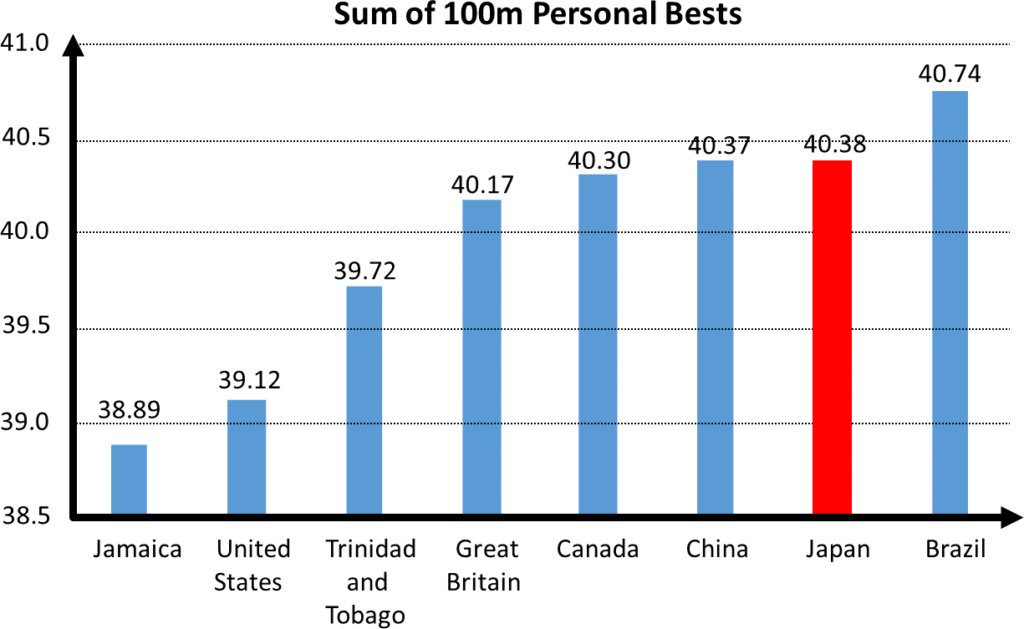 Good problem solving can seriously help you with the performance in your plant. John Shook recently pointed out another nice example to me: the Japanese Men’s 4x100m relay team during the 2016 Olympics in Rio. They were the underdogs, with none of their team having ever run 100m in under 10 seconds. Yet they stunningly won the silver medal! They achieved this through good problem solving. Let me show you the details:
Good problem solving can seriously help you with the performance in your plant. John Shook recently pointed out another nice example to me: the Japanese Men’s 4x100m relay team during the 2016 Olympics in Rio. They were the underdogs, with none of their team having ever run 100m in under 10 seconds. Yet they stunningly won the silver medal! They achieved this through good problem solving. Let me show you the details:
By the way, this is a cross-post, with the same article appearing on Planet Lean almost simultaneously.
Introduction
First of all, let me point out that I was a swimmer, but never a runner. In fact, I run more like a three-legged cow that is tied to a post. And this is even without carrying a stick … I mean a BATON … of course I know it is called a baton … never mind, back to the topic, please!

Anyway, during the 2016 Rio Olympic Games, the Japanese team was quite the underdog. No runner on their team ran 100m faster than 10 seconds, whereas all other teams in the final (except Brazil) had at least one runner faster than 10 seconds over 100m. In fact, all runners on the US team and the Jamaican team could run 100m in less than 10 seconds, including the world record holder, Usain Bolt on the Jamaican team, with 9.58 seconds.
Below is the overview of the sum of the personal records of the runners of each team in seconds. Jamaica had Usain Bolt and other excellent runners, and the sum of their personal records comes to 38.89 seconds. Japan is the second-slowest team in the finals, after Brazil, summing up to 40.38 seconds.
Looking purely at these numbers, Japan should have had no chance on any medal. Instead, Jamaica, the US, and Trinidad would be on the podium. Yet Japan made second place, after Jamaica! Below is how many seconds the relay time of each team was faster than their personal bests. Relays are usually faster than the individual times, since three of the four runners have a running start. Here, Japan outscored all the other teams. Through their superior baton handovers, they gained over one second on Jamaica and the USA, which had the sloppiest handovers (and the USA also got disqualified for handing over outside of the zone). A one-second advantage is huge in Olympic 4x100m relay races.
This is due to their superior problem solving, use of standards, and outstanding performance with the baton handover. Let’s look at the details.
General Handover
 The 4×100 m relay race has four runners over 100m each. They carry a baton (never a stick!), and hence three times they have to give the baton to the next runner. This handoff has to happen in a changeover box. If they miss this zone, they are disqualified (which happened to the US team in the finals, but they were still behind Japan).
The 4×100 m relay race has four runners over 100m each. They carry a baton (never a stick!), and hence three times they have to give the baton to the next runner. This handoff has to happen in a changeover box. If they miss this zone, they are disqualified (which happened to the US team in the finals, but they were still behind Japan).
The speed and quality of the handover is crucial for winning, and hence this is a much-researched topic in sports. Many teams fail because they mess up the handover or even drop the baton altogether. Having to hold your hand in position for the baton handover reduces your running speed. Usually, the next runner just holds his hand in place without looking, and the previous runner places the baton in the hand. Some verbal shouts can help with the timing of the process.
Where to Hold the Baton?
 There are different possibilities for how you could hold the baton, but it seems most athletes like to hold the baton at the bottom (number 1 in the image). This seems to make running easier. (I actually tried this out, and it is indeed easier – but then, I can’t really run).
There are different possibilities for how you could hold the baton, but it seems most athletes like to hold the baton at the bottom (number 1 in the image). This seems to make running easier. (I actually tried this out, and it is indeed easier – but then, I can’t really run).
The Problem with the Handover Position
 This now creates a problem for the handover process. The easiest way to hand over the baton would be an upsweep roughly at hip height as shown in the image here. The baton would be roughly horizontal.
This now creates a problem for the handover process. The easiest way to hand over the baton would be an upsweep roughly at hip height as shown in the image here. The baton would be roughly horizontal.
 However, this upsweep creates the problem that the next runner holds the baton in the wrong spot (number 3 or number 2 of the baton positions above). The runner would either have to run with an odd baton position, switch hands, or have to adjust the baton, which requires two hands or increases the risk of dropping it. All of these options will slow him down.
However, this upsweep creates the problem that the next runner holds the baton in the wrong spot (number 3 or number 2 of the baton positions above). The runner would either have to run with an odd baton position, switch hands, or have to adjust the baton, which requires two hands or increases the risk of dropping it. All of these options will slow him down.
If the subsequent runner wants to grab the baton in an upsweep position, that is good for him; he would find the hand of his teammate already there. Hence, the hand of the previous runner is completely in the way for the next runner.
 The normally used alternative involves literally quite a bit of arm-twisting. The next runner twists his arm and hand upward so that he can grab the baton from below. This way the baton will be in a good position for the next leg to run (number 1 from the baton positions above). The baton is almost vertical during the handover.
The normally used alternative involves literally quite a bit of arm-twisting. The next runner twists his arm and hand upward so that he can grab the baton from below. This way the baton will be in a good position for the next leg to run (number 1 from the baton positions above). The baton is almost vertical during the handover.
 Unfortunately, this twisting comes at a cost. The hand and arm has to be very high, tilting the upper body of the runner forward. Overall, this makes it harder to run.
Unfortunately, this twisting comes at a cost. The hand and arm has to be very high, tilting the upper body of the runner forward. Overall, this makes it harder to run.
Here is a picture of such a handover from a real race (World Youth Championships 2013, Team USA). Notice the high hand position. Looking over your shoulder is also time consuming and not advised, but happens even in Olympic races.
Japanese Problem Solving
Japanese people seem to have excellent skill in problem solving. Enter Shunji Karube (苅部 俊二), a former runner specializing in 400m, and now a professor for sports at the Hosei University, Tokyo (his blog in Japanese). He has been researching running and relays for a long time. Since 2014 he has worked for the JAAF (Japan Association of Athletics Federations) on improving and researching the relay race.

My experience with Japanese problem solving is that they look at many, many different solutions and try out a lot. While I don’t know in detail how Karube progressed, at one point he questioned the problem of putting the hand on top of the other. He probably also involved many other runners and experts to tackle the problem. And he found a solution.
Japanese athletes do indeed put their hands pretty much on top of each other. It does not look easy, but they manage it effortlessly. It reminds me a little bit of how to hold a Japanese sword (of which I know a little bit more. I proudly hold the 6th kyu in Kendo … although if you know Japanese martial arts, you know that this is the level of six-year-old children in Japan … never mind, just trying to impress you with fancy Japanese words … after all that what lean is all about … or maybe not?)
Anyway, the above sketch merely gives a glance at the detail of the standard, and there is much more (that I don’t know about). The receiver spreads his hand wide, and the previous runner slides it forward right in the web of the thumb very close to his hand. The receiver grabs it and the previous runner pulls his hand out from underneath the next runner’s hand. (The French do something similar, but with an upward sweep)
There are definitely verbal clues so the next runner doesn’t have to look behind his shoulder. I could imagine synchronizing the steps may be significant. It is already common knowledge to always hand left to right or right to left hand, and that the last runner should be the fastest, although I am sure Karube looked into this too. They also considered the reliability of the handover. Baton passes are notoriously tricky, and many teams in world-class races fail or disqualify themselves due to a faulty pass.
They also tweaked the technique to improve the distance between runners during hand over. The further apart the runners are, the less they have to actually run. Compared to 2008 they improved by almost 1 meter per hand over, turning a 4x100m relay into a 100+3x99m race. Here the previous runner does most of the reaching out. Naturally, they also optimized the time for the hand over, requiring much less fiddling than other teams.
The shoulder position was also optimized. Previously the shoulders of the next runner tilted to the right by about 15° when receiving in the left hand. Now, the shoulders are almost level. They also researched other things like the optimal handover point (middle of the zone, except for the first runner, where it is the last third), adjusting the trigger point signaling the next runner to start, and many other things with the help of three high-speed cameras.
Standardization
Next is getting the standard to the people. Unfortunately, the team is set up only shortly before the Olympics. However, Karube worked with the potential candidates six months in advance to extensively train his guys on the handover. In contrast, the Jamaican team practiced only a few times before the actual race.
Continuous Improvement
There is no standard that cannot be improved, and Karube has his sights already set on more details and improvements to make the Japanese team even faster. After all, the 2020 Olympics are on their home turf in Tokyo, Japan, and they surely would like a gold medal there 🙂 .
Videos
The video of the final is on the Olympic website here. Due to copyrights (the Olympics is all about money, after all), it is not on YouTube. However, the Japanese broadcast ended up on Twitter. Note how low the baton hand over is of the Japanese team compared to the others.
#オリンピック【陸上男子400mリレー決勝】山縣亮太→飯塚翔太→桐生祥秀→ケンブリッジ飛鳥とバトンを繫いだ日本チームの走り。アンカーにボルトが控える4レーン ジャマイカのすぐ隣り、5レーンを走るのが日本チームです。#Rio2016 pic.twitter.com/iRSH1CADTM
— ひぞっこ (@musicapiccolino) August 20, 2016
Here’s a video of the handover from Twitter. Notice how low the handover is, and that the two hands are almost on top of each other.
富士吉田での代表合宿を終えました。
準高地の練習は疲れが抜けにくい…4年前はそんなことなかったんだけど。笑けど素晴らしい環境で練習をさせて貰いました。本番も頑張ります。あと、お陰様で公式マークつきました。 pic.twitter.com/K6na2GBcUa— 山縣 亮太 (@V7Jqq) July 28, 2016
Finally, here are two YouTube videos with two different angles of a demonstration the team did during a press conference:
So this post was something outside of lean for a change, but still interesting (I hope) to lean practitioners. Now, go out, make sure your guys don’t drop the baton, and organize your industry!
Selected Sources
Japan’s Secret To Relay Success; Spikes, January 12 2017
P.S.: Many thanks to John Shook for giving me the idea on this topic during the Lean Global Network meeting in Barcelona and Tenerife.
P.S.2: Many thanks to Prof. Shunji Karube for his input and the permission to use his photo.




Awesome !. Great to see the smiles of that team as they realized what they had done. Teams should celebrate their accomplishments..
Impressive!
Didn’t they also do this in swimming in the 1920’s? They won a bunch of medals until everyone else starting following them.
Hi Adam, didn’t know about this. Do you have more information? I do know that butterfly swimming was created because originally during breaststroke you were allowed to bring the arms to the front any way you want, and the US team did it over water, being much faster. To level out the playing field they created a new style “butterfly”. Also some lateral thinking 🙂
Hello Christoph, I watched this video on it from youtube. Fascinating stuff, they did the same kind of problem solving you mention. It seems Japan puts a lot of effort and funding into Sports/Olympic research.
https://youtu.be/Ka2tjzijvRw
Very interesting history.
Hi Adam, that is indeed a very cool video! Many thanks for sharing!
Season bests should be compared, instead of personal bests. I think Japan’s personal bests (40.38) equal seanson bests. If compared seanson bests, Japan should be ranked higher. In addition, the order of running is important. Yamagata (1st) and Kiryu (3rd) are good at running at the corner.
Dear Nakajima, that is probably correct. I used the data I had available. But thanks for your insight.